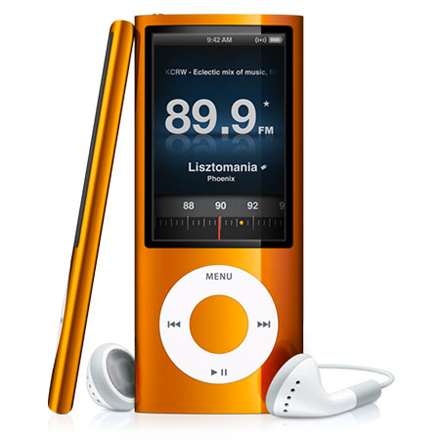
Just when you think there’s nothing interesting you can blog about, Apple come and chuck fresh meat to the wolves.
Of course, everyone’s excited about Apple including radio in one of their devices for the first time. That’s clearly good news. It would be amazing news if it was a DAB Radio in Europe, and an HD Radio in the States, but let’s work on that one. Baby steps.
Let’s assume that Apple don’t incorporate functionality into their devices unless they think users are going to go “wow – cool”. As Mark Ramsay says, Apple didn’t just throw an FM tuner in there; they “enhanced radio”, so it includes pause/rewind and tagging. Adding this kind of functionality costs real money (in material and engineering time), so we should be pleased that Apple see that as a worthwhile investment. Yes, Radio is still cool, and still valued even by the cool kids who buy Apple iPod Nanos. This is a “radio” that 15-24s will love to have.
James explains a bit about how the existing Apple iTunes Tagging works. It’s a system designed to do one very specific job, for one specific group of stations and listeners. It transmits Apple iTunes Catalogue IDs in spare RDS ODA (Data) groups, using a form of encryption (discuss…). The radio station incorporates the iTunes IDs into their FM RDS transmission, the iPod Nano receives/decodes this, and when you hit “Tag” it stores the ID/Artist/Title in memory. When you sync up your Nano with iTunes, iTunes converts that into proper store links, and offers you the downloads. It works. Listeners can tag songs on the radio, and buy them in iTunes. A similar service is also available on HD Radio, and was launched earlier, IIRC.
So what’s not to like. Isn’t this the perfect demonstration of innovative revenue generation in a digital media world?
Maybe, but I don’t think it was initially designed with the listener in mind. It looks like a system designed to turn radio listeners into Apple iTunes customers. There’s nothing wrong with that, incidentally. The rather depressed radio business got a big kick out of being able to announce a tie-up with Apple, who are highly regarded. There’s significant kudos is being allowed to play with the smartest boys on the block.
James has pointed out the weaknesses in the existing system. It doesn’t scale terribly well (although HD appear to be also transmitting different tagging information to support Microsoft’s new Zune HD), and it only works for iTunes and material that’s in iTunes.
There another weakness in the system, in my opinion.
If you look at how the meta-data moves around, it goes in one direction only. From the radio station, via FM, the Nano, iTunes and to Apple. After the radio station has splurged the meta-data out on the broadcast platform, it has no control or visibility of it from that point onwards. There has to be a contractual relationship between Apple and each Radio Station for Apple to pass information about the songs sold back to the radio station. I have no idea how detailed that information is. Does it list every transaction, by every device, by time of day? Does it report transactions, or tagging events, or both? Or do they just get a $ total each month and a cheque for the affiliate fees?
Excluding the broadcaster from the process, and obfuscating the outcome, diminishes the value for radio. It turns us into an customer acquisition vehicle, without getting rich information on listener behaviour.
There’s also the small problem of ne’er do wells “stealing” the meta-data. Let’s assume that someone nefarious decides to strip that meta-data, and amend the affiliate ID to be their own. You might use an apparently legitimate streaming portal, or attractive device, and that money would go to the middle-man, not the radio station. The value of meta-data is increasing, and we should be more careful about whom we exchange it with. In my opinion, broadcasting meta-data risks destroying value. I do agree that meta-data should be open, but I generally think that you should know who you’re providing it to. (I’m going to blog about the side-effects of this shortly).
As you’d expect, I think the RadioTAG model is fairer. It keeps our meta-data relatively secure, whilst still allowing legitimate users (like listeners and Apple) to have access to all the information they need. It scales well, because it’s not transmitting vendor specific information over the air. The broadcaster can see who is requesting what meta-data when, and use that to track listener behaviour in real-time. And very importantly, it lets people tag anything interesting they hear on the radio, not just the songs.
I’m excited that Apple are into radio. I’m excited that the Nano is such a great little device. I’m excited for the prospects of Tagging on the Nano. I just want to make sure we make it great for listeners, as well as for radio stations and for Apple.